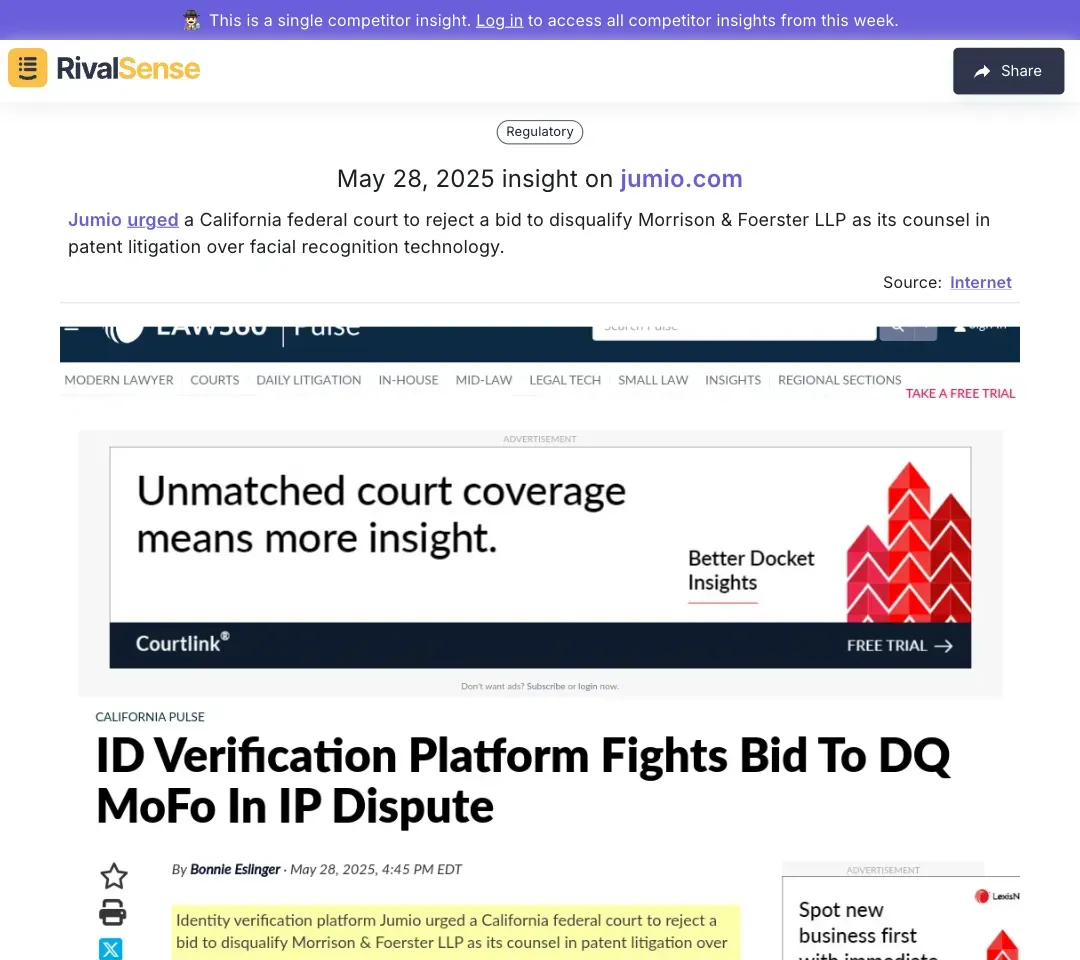How Jumio's Legal Move Reshaped Competitive Strategy in Digital Identity
The digital identity verification sector thrives on innovation and rapid market shifts, with Jumio historically setting industry standards through AI-powered solutions. Before the pivotal legal action, competition centered around price wars and feature parity, creating a volatile environment where agile responses determined success. For B2B leaders, understanding these dynamics is critical for sustainable positioning.
🔑 Actionable Takeaways:
- Assess Market Positioning: Map competitor differentiation across pricing, tech, and service models
- Track Competitive Moves: Monitor announcements, updates, and partnerships for early trend detection
- Align with Client Needs: Prioritize development around core customer values (cost vs. innovation)
- Maintain Strategic Agility: Build contingency plans for sudden market disruptions
The Legal Move: Jumio's Strategic Decision
Jumio's patent infringement lawsuit marked a seismic shift in competitive dynamics, asserting dominance through legal channels rather than purely commercial tactics. This move instantly elevated Jumio's perceived technological authority while casting doubt on the rival's product integrity—demonstrating how legal actions can become potent competitive weapons beyond traditional marketing.
💼 Strategic Implications:
- Immediate credibility boost for the plaintiff
- Scrutiny of defendant's IP practices
- Industry-wide reassessment of partnership risks
✅ Practical Defense Playbook:
| Action | Business Impact |
|---|---|
| Proactive IP Audits | Prevents infringement vulnerabilities |
| Competitor Legal Monitoring | Early threat detection |
| Transparent Stakeholder Comms | Maintains trust during disputes |
| Scenario-Based Legal Protocols | Enables rapid response |
Rival's Response: Adapting Under Pressure
Facing legal pressure, the competitor demonstrated crisis management agility by forming cross-functional teams spanning legal, product, and strategy units. This approach balanced urgent adaptation with deliberate risk assessment—proving that effective responses require both speed and precision. Key challenges included retaining customer confidence while making product alterations.
🛠️ Adaptation Framework:
- Product Pivot: Modified features to mitigate legal exposure
- Communication Overhaul: Transparent customer messaging about compliance
- Partnership Diversification: Reduced dependency on contested technology
📋 Execution Checklist:
- [ ] Assemble rapid-response team (legal + product)
- [ ] Conduct 360° impact analysis
- [ ] Develop tiered customer retention plan
- [ ] Identify alternative revenue streams
Market Dynamics Post-Legal Move
The lawsuit triggered measurable shifts in customer trust metrics and competitor behavior, with rivals accelerating R&D investments to distance themselves from the contested technology. This phase revealed how legal actions create secondary opportunities—companies capturing dissatisfied clients gained market share while others faced intensified regulatory attention.
🌐 Opportunity Capture Tactics:
- Sentiment Tracking: Use social listening tools to identify shifting perceptions
- Gap Exploitation: Target underserved customer segments
- Strategic Piloting: Test new features in low-risk markets
- Alliance Building: Partner with compliance-focused firms
Long-Term Outcomes and Strategic Lessons
The litigation's ripple effects extended beyond courtrooms—Jumio solidified premium positioning while the rival incurred product delays and resource drains. This underscores legal intelligence as a core competitive capability, not just a reactive measure. Real-time tracking of competitor legal maneuvers provides predictive insights for strategic planning.
RivalSense Insight in Action:
Jumio urged a California federal court to reject a bid to disqualify its counsel in patent litigation—a critical development signaling intensified legal commitment. Monitoring such proceedings helps anticipate resource allocation shifts and potential market openings when competitors are distracted.
📚 Legal Intelligence Framework:
- Patent Tracking: Identify emerging tech battles
- Litigation Pattern Analysis: Predict competitor strategic focus
- Regulatory Monitoring: Spot compliance-driven pivots
Conclusion: Legal Strategy as Competitive Leverage
Jumio's approach proves that legal actions can reshape market hierarchies as effectively as product innovations. Modern competition demands integrated strategies where legal, product, and intelligence functions collaborate seamlessly. The most resilient companies treat legal developments as early-warning systems rather than isolated events.
🔭 Future-Proofing Actions:
- Embed Legal Scanning: Make competitor litigation tracking routine
- Simulate Scenarios: Stress-test strategies against potential lawsuits
- Diversify IP Portfolios: Create layered innovation protection
Transform Competitive Intelligence:
RivalSense delivers actionable insights on competitor legal moves, product launches, and market shifts through curated weekly reports.
📚 Read more
👉 Data-Driven Insights on Advocacy Program Competitors Online
👉 Optimizing DevOps for Competitive Edge in Salesforce Development
👉 Data-Driven Insights on Competitor Hiring & Layoff Trends
👉 5 Key Benefits of Continuous Competitor Monitoring (with Real Examples)
👉 Unlocking Investment Success: The Strategic Value of Tracking Portfolio Companies

